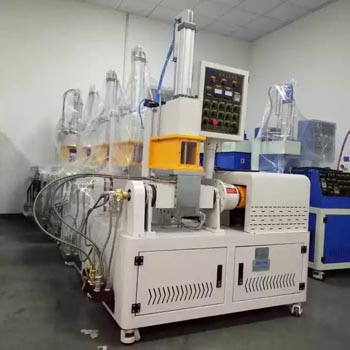In modern manufacturing industries ,for much time ,we are faced with the high-viscosity (with viscosities ranging from 200,000 cps up to 1,000,000 cps) material, such as rubber, silicone, adhesives, sealants, and high-performance polymers, to handle in these high-viscosity materials is really unavoidable and challenging.
Since these high-viscosity material are heavy compound material ,they are very stick and thick, not easy to flow freely , thus these material require powerful mixing equipment that ensures uniform blending and homogenized mixture but without compromising quality. Among various mixing equipment, the laboratory sigma kneader, also named as lab kneader, is a common choice for R&D labs formulation and small-batch production.
In this blog, Let us explore how lab kneaders handle these high-viscosity materials and how discharge the compound material after mixing.
1. Can Laboratory Kneaders Handle High-Viscosity Materials? ✅
Yes, laboratory kneaders are specially designed to process these material effectively. , from medium- to high-viscosity material, including rubber compounds , silicone elastomers , Hot-melt adhesives, sealants & mastics ,plastic master batches and high-viscosity resins and polymers ,ceramic powder and pharmaceumicals etc.
A standard lab kneader feature with two Z-shaped sigma blades ,which rotate at different speeds in opposite direction inside a sealed mixing chamber. The rotating action generates strong shear forces, compression, and stretching actions on the compound material, which makes it blended and mixed homogenized evenly and fully .
2. Why Is Discharging High-Viscosity Material Difficult?
Usually ,these material whose viscosities is ranging from 200,000 cps up to 1,000,000 cps belong to high-viscosity materials, they are often difficult to mix, homogenize, and discharge, because several reason as follows:
* Low flowability
* Easy to stick to mixing blades and walls of chamber
* Require precise temperature control to soften or prevent curing
* Need intensive kneading torque to disperse material evenly and uniformly
3. The Mixing Procedure for High-Viscosity Materials
A laboratory kneader uses a batch mixing process,specially designed to provide intensive shearing and dispersion to the compound material.
Step-by-Step Procedure of Mixing of Lab Kneader
Step 1 — Compound Material Are Fed
Firstly , the raw materials are loaded manually or via a feeding port, these high-viscosity including rubber compound, silicone, ceramic powder , pigments, color masterbatch or resins etc need to be pre-heated to soften the compound materials for next process.
Step 2 — Knead and & Disperse
When the compound material reach the mixing chamber , the two Z-blades begin rotating at different speeds in opposite direction ,so that generate intense shearing forces to the compound material.
For silicone and rubber material , a jacket system for heating can help to soften the compound material.
In addition , if equipped with vacuum system , it also can remove air bubbles and moisture , improving final product density and ensuring
a uniform and high-quality final product.
Step 3 — PLC Control System
A PLC-controlled system accurate control and monitors torque, temperature, and mixing time., mixing speed, temperature, pressure, and process duration.
For extremely sticky compounds, anti-adhesive coatings on blades can remove the buildup of compound material .
3. Methods to Discharge High-Viscosity Material
Different from low-viscosity liquids material , high-viscosity compound material are not easy to flow , it require special tool by manual labor to discharge and manually scrape materials using spatulas , avoiding the material stick to the chamber and causing material loss ,especially for rare and expensive material.
To discharge the material ,there are two ways for option as follows:
3.1. Tilting Discharge System
The chamber tilts of lab kneader adopt a hydraulic or pneumatic system. Due to gravity assistance, these compound material can directly discharged out and then into collection trays.
Through this tilting discharge design system , it can reduce operator effort and improve the efficiency of discharging material .
3.2. Extruder Discharge System
The lab dispersion kneader can also be integrated with extruder system ,which Reduces labor costs and speeds up batch cycles and also avoids manual scooping.
The processed compound material is pushed forward under pressure through the extruder screw automatically and exits smoothly, forming continuous strips or pellets.
Th extruder discharge way is continuous, efficient, and safe, eliminating the need for manual material removal, it is suitable for high-viscosity rubber, silicone, and adhesives.
In conclusion , It is very challenging to handle and discharg high-viscosity materials with a laboratory dispersion kneader , but if we can try finding some other right way , for example we can equip right discharge system—by manual scraping, tilting discharge port , or come with extrusion system, through these small hallenges, these difficulties can be overcome easily .
if you need to handle high-viscosity mixing frequently, you’d better use kneaders with extruder to discharge material , as it would not only save your time ,but also it would reduce material waste and decrease the sample formulation cost .
If you have any problem or difficult for these high-viscosity material ,welcome to contact Simptek team.
WE ARE ALWAYS HERE FOR YOU !







